#french film essays
Explore tagged Tumblr posts
Text
The French New Wave: A Cinematic Revolution.
Introduction
The French New Wave, or Nouvelle Vague, is a cinematic movement that revolutionized French cinema and, by extension, global cinema. Emerging in the late 1950s, it marked a decisive break from the conventions of traditional filmmaking. This movement not only redefined the rules of directing but also spotlighted new talents who would go on to influence generations of filmmakers.

Origins of the French New Wave
The movement was born out of criticism, particularly through journals like Cahiers du cinéma, where young cinephiles such as François Truffaut, Jean-Luc Godard, and Éric Rohmer began expressing their dissatisfaction with the rigidity of French cinema at the time. These critics soon transitioned behind the camera to materialize their innovative ideas.
Characteristics of the French New Wave
- Narrative Freedom : Films of the New Wave are characterized by non-linear storytelling and a liberated approach to narrative structure. Plot often takes a back seat, with emphasis placed on emotion and the moment.
- On-location Filming : Unlike traditional cinema, which predominantly relied on studio settings, New Wave directors favored natural locations, lending their films a more realistic and immediate feel.
- Innovative Camera Techniques : The directors experimented with groundbreaking camera techniques such as handheld shots, long takes, and rapid editing. This dynamic approach contributed to a unique aesthetic that often blurred the lines between fiction and documentary.
- Non-professional Actors and Improvised Dialogues : To enhance realism, many New Wave filmmakers cast non-professional actors and encouraged improvisation, resulting in more natural and spontaneous dialogue.

Pioneering Figures
- Jean-Luc Godard : With films like Breathless (À bout de souffle, 1960), Godard introduced a bold and provocative style, challenging conventional editing and narrative techniques.
- François Truffaut : In The 400 Blows (Les 400 Coups, 1959), Truffaut explored autobiographical themes with a new sensibility, deeply resonating with audiences.
- Agnès Varda : Although sometimes considered on the periphery of the movement, Varda contributed significantly with works like Cléo from 5 to 7 (Cléo de 5 à 7, 1962), enriching the New Wave with a feminine and introspective perspective.



Three Must-See Films of the French New Wave
1. Breathless (1960) - Jean-Luc Godard
One of the cornerstones of the French New Wave, Breathless tells the story of Michel Poiccard, a petty criminal on the run, and his love for a young American, Patricia. The film is renowned for its innovative editing style, with abrupt cuts and a frenetic pace. Godard disrupted traditional cinematic conventions, delivering a daring work that perfectly embodies the rebellious spirit of the movement.

2. The 400 Blows (1959) - François Truffaut
Truffaut’s debut feature is an autobiographical masterpiece that follows the misadventures of Antoine Doinel, a young boy rebelling against authority. The 400 Blows is a poignant film that explores childhood, the misunderstanding of adults, and the quest for freedom. The film is distinguished by its realism and sensitivity, hallmarks of the New Wave.

3. Cléo from 5 to 7 (1962) - Agnès Varda
Often referred to as the "grandmother" of the New Wave, Agnès Varda offers an introspective and feminist perspective with Cléo from 5 to 7. The film follows Cléo, a singer awaiting potentially grave medical test results. Over the course of two hours, we watch her traverse Paris, encountering various characters. The film is remarkable for its exploration of time, mortality, and identity, while also capturing the essence of Parisian life.

The Impact of the French New Wave
The French New Wave profoundly influenced global cinema, paving the way for a new generation of directors willing to break conventions, both in Europe and in the United States. Filmmakers like Martin Scorsese, Quentin Tarantino, and Wong Kar-wai have frequently cited the New Wave as a major source of inspiration.
Conclusion
The French New Wave remains a pivotal movement in the history of cinema. By breaking with tradition and innovating both in form and content, these directors redefined what cinema could be. Even today, their influence is felt, proving that the New Wave has left an indelible mark on the art of filmmaking.

(yes it is)
#coquette#it girl#lana del rey#girlboss#jane birkin#lizzy grant#60s girl#lanadelrey#vintage#girlblogging#nouvelle vague#new wave#Godard#francois truffaut#jean luc godard#Agnès Varda#70s aesthetic#70s vintage#60s icons#films#movies#movie review#critique#essai#french
30 notes
·
View notes
Text

Seen in 2024:
Kashima Paradise (Benie Deswarte & Yann Le Masson), 1973
#films#movies#stills#docs#documentary#Kashima Paradise#Benie Deswarte#women directors#Yann Le Masson#French#1970s#seen in 2024#essay-film
20 notes
·
View notes
Text
it took TEN MINUTES. ten minutes of my time on this godawful website and now i’ve been chucked headfirst back into this stupid interest like that gayass angel guy being thrown into superhell
#i cant believe it#AND IN THE MIDDLE OF TEST WEEK AS WELL#I WANT TO SIT AND REREAD IT BUT NOOO I HAVE TO PRACTICE WRITING AN ESSAY ABOUT OUR FRENCH FILM STUDY#i’ve had enough#🎪 my thoughts 🎪#it 1986#reddie
11 notes
·
View notes
Video
youtube
The Racist Cisgender Nonsense of Emilia Perez - Jessie Gender
Looks like Netflix wants to bury critiques of their transphobic awards darling movie. So I’ll share. Give it a watch, Jessie really knows how to make a 2 hour video essay engaging.
#youtube#breadtube#emilia perez#jessie gender#lgbtqia#trans#karla sofía gascón#selena gomez#zoe saldana#french movie nonsense#bad movie#movie critique#film critique#video essay#cn transphobia#translation#trans movies
2 notes
·
View notes
Text


WHEN ANIMALS DREAM (2014) dir. Jonas Alexander Arnby & RAW (2016) dir. Julia Ducournau
#i had a feeling these movies would be “cousins” but i'm shocked with how much they actually match#even the poster quotes????? LIKE#“the truth is known to all but one” is so Justine with her family#and “what are you hungry for?” is SO Marie through her arc#her arcs are kind of the same too although the girls are not that alike#i kind of want to write an essay about it all#when animals dream#2014#når dyrene drømmer#jonas alexander arnby#sonia suhl#danish movie#danish film#raw#raw 2016#grave#grave 2016#julia ducournau#garance marillier#french movie#french film#horror movies#horror film#bloody women
2 notes
·
View notes
Text
youtube
Nerdstalgic x "The Moment We Got Tired of Wes Anderson".
Wes Anderson is a director with very specific tastes. [...] But as time went on, his symmetrical framing, limited palate, and quirky characters all started to feel part of a formula.
#nerdstalgic#video#film#film essay#video essay#cinema#moonrise kingdom#focus features#searchlight pictures#fox searchlight#grand budapest hotel#the grand budapest hotel#the darjeeling limited#darjeeling limited#hotel chevalier#isle of dogs#the royal tenenbaums#royal tenenbaums#rushmore#the french dispatch#french dispatch
3 notes
·
View notes
Text
devastating: the feminist essay didnt actually watch the movie
#read 2 essays abt paris texas because i was trying to understand the argument against it#post answers any questions u may have abt the essays#its not a feminist film no but it is in fact far from misogynistic. huzzah#the main problem is people watch it and go 'what the fuck this man is so shitty why are we supposed to agree with him' when the movie tells#you many times that you are not supposed to agree with him#also both of them said we are 'manipulated into empathising with him' which is how all stories work#you are told how to feel about a character through contexts theyre shown in. this is how you tell a story#and if its a good story they dont point at it and say 'this one was bad' they let you decipher that for urself#spoilers (u should watch it its a Great movie) but ur not supposed to think hunter going back to mum is good. they tell you this twice#explicitly through the women of the film. (the french lady so afraid of losing him and loves him so much. and the og mum finally able to#move on from the horrific life experiences she had from aged 17-18 told through her monologue. like come on. watch the movie)
5 notes
·
View notes
Note
can i use one of your jade drawings in a slideshow on homestuck as a fandom subculture that i have to do for school?(i’ll credit you:))
Yep! Thanks for asking! Hope you get a good grade!
#ask#anon#I did a final video essay comparing homestuck to classic french experimental film La Jetee and I had fun AND got a good grade#more people need to do school projects on homestuck I think
8 notes
·
View notes
Text
youtube
Wes Anderson: Style and Substance and Being Alive
#video essay#wes anderson#the grand budapest hotel#moonrise kingdom#asteroid city#french dispatch#film#rushmore#fantastic mr fox#life aquatic#Youtube
8 notes
·
View notes
Text
20s // just for me
#m: tv#m: film#m: book#l: english#l: chinese#l: Korean#l: thai#l: turkish#l: arabic#l: spanish#l: french#l: german#l: japanese#g: romance#g: horror#g: fantasy#g: historical#g: coming of age#l: indian#m: manga#m: poetry#m: essay
0 notes
Text
"The Gutenberg Revolution of the mid-15th century, marked by the invention of the printing press, was a pivotal moment in media history. It enabled the mass production of books and printed materials, making information widely accessible and challenging traditional authorities. This democratization of knowledge set the stage for modern media institutions and their role in shaping public discourse."
When I wanted to ask AI to help me better understand what the Institutional Mode of Representation is, I didn't ask it to consider the invention of the printing press at any stage in the process. But from very early, it became apparent that AI knew more than I did and that the printing press was important for understanding this cinematic concept (and managed to correct the name of the IMR in the process). I'm sure there's lots of useful information here, and no waffle or outright deceits!
0 notes
Text
i went over everything I have to do for school over fall break n it’s mostly Watch Movies. better get some popcorn huh
#I mean I gotta write an essay about a couple of em but still lol#like 7 or 8 dif films between 2 classes#quiet emily#all but one of them r Japanese films#(the last one is French-Senegalese)
0 notes
Text

Seen (again) in 2024:
Sans Soleil (Chris Marker), 1983
#films#movies#stills#docs#documentary#Sans Soleil#Chris Marker#French#1980s#Japan#essay film#seen in 2024
1 note
·
View note
Text
Beginner’s Guide to Medieval Arthuriana
Just starting out at a loss for where to begin?
Here’s a guide for introductory Medieval texts and informational resources ordered from most newbie friendly to complex. Guidebooks and encyclopedias are listed last.
All PDFs link to my Google drive and can be found on my blog. This post will be updated as needed.
Pre-Existing Resources
Hi-Lo Arthuriana
♡ Loathly Lady Master Post ♡
Medieval Literature by Language
Retellings by Date
Films by Date
TV Shows by Date
Documentaries by Date
Arthurian Preservation Project
The Camelot Project
If this guide was helpful for you, please consider supporting me on Ko-Fi!
Medieval Literature

Page (No Knowledge Required)
The Vulgate Cycle | Navigation Guide | Vulgate Reader
The Wedding of Sir Gawain and Dame Ragnelle
The Marriage of Sir Gawain
Sir Gawain and The Green Knight
The Welsh Triads
Le Morte d'Arthur by Sir Thomas Malory
Squire (Base Knowledge Recommended)
The Mabinogion
Four Arthurian Romances by Chrétien de Troyes
Owain (Welsh) | Yvain (French) | Iwein (German)
Geraint (Welsh) | Erec (French)| Erec (German)
King Artus
Morien
Knight (Extensive Knowledge Recommended)
The History of The King's of Britain by Geoffrey of Monmouth
Alliterative Morte Arthure
Here Be Dragons (Weird or Arthurian Adjacent)
The Crop-Eared Dog
Perceforest | A Perceforest Reader | PDF courtesy of @sickfreaksirkay
The Fair Unknown (French) | Wigalois (German) | Vidvilt (Yiddish)
Guingamor, Lanval, Tyolet, & Bisclarevet by Marie of France
The Canterbury Tales by Geoffrey Chaucer
Grail Quest
Peredur (Welsh) | Perceval + Continuations (French) | Parzival (German)
The Crown by Heinrich von dem Türlin (Diu Crône)
The High Book of The Grail (Perlesvaus)
The History of The Holy Grail (Vulgate)
The Quest for The Holy Grail Part I (Post-Vulgate)
The Quest for The Holy Grail Part II (Post-Vulgate)
Merlin and The Grail by Robert de Boron
The Legend of The Grail | PDF courtesy of @sickfreaksirkay
Lancelot Texts
Knight of The Cart by Chretien de Troyes
Lanzelet by Ulrich von Zatzikhoven
Spanish Lancelot Ballads
Gawain Texts
Sir Gawain and The Green Knight
The Wedding of Sir Gawain and Dame Ragnelle
The Marriage of Sir Gawain
Sir Gawain and The Lady of Lys
The Knight of The Two Swords
The Turk and Sir Gawain
Perilous Graveyard | scan by @jewishlancelot
Tristan/Isolde Texts
Béroul & Les Folies
Prose Tristan (The Camelot Project)
Tristan and The Round Table (La Tavola Ritonda) | Italian Name Guide
The Romance of Tristan
Tristan and Iseult by Gottfried von Strassburg
Byelorussian Tristan
Educational/Informational Resources
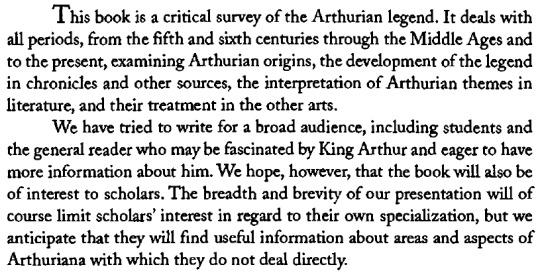
Encyclopedias & Handbooks
Warriors of Arthur by John Matthews, Bob Stewart, & Richard Hook
The Arthurian Companion by Phyllis Ann Karr
The New Arthurian Encyclopedia by Norris J. Lacy
The Arthurian Handbook by Norris J. Lacy & Geoffrey Ashe
The Arthurian Name Dictionary by Christopher W. Bruce
Essays & Guides
A Companion to Chrétien de Troyes edited by Joan Tasker & Norris J. Lacy
A Companion to Malory edited by Elizabeth Archibald
A Companion to The Lancelot-Grail Cycle edited by Carol Dover
Arthur in Welsh Medieval Literature by O. J. Padel
Diu Crône and The Medieval Arthurian Cycle by Neil Thomas
Wirnt von Gravenberg's Wigalois: Intertextuality & Interpretation by Neil Thomas
The Legend of Sir Lancelot du Lac by Jessie Weston
The Legend of Sir Gawain by Jessie Weston
#arthuriana#arthurian legend#arthurian mythology#arthurian literature#king arthur#queen guinevere#sir gawain#sir lancelot#sir perceval#sir percival#sir galahad#sir tristan#queen isolde#history#resource#my post
1K notes
·
View notes
Text
An anonymous individual asked @awildwickedslip for recommendations of literary criticism on the gothic, and she directed them to me, so I thought it was time I make a rec list on the topic.
I'm keep this to more general analyses, but of course have a lot of recommendations for more works on more specific texts (especially but not limited to Dracula).
I'm also including some things that are more properly about amatory or epistolary fiction, because I think an understanding of those genres will serve you well in contemplating the gothic.
Mario Praz, The Romantic Agony
Nina Auerbach, Our Vampires, Ourselves
Christy Desmet and Anne Williams (eds), Shakespearean Gothic
Kate Ferguson Ellis, The Contested Castle
David J. Skal, The Monster Show: A Cultural History of Horror
Devendra P. Varma, The Gothic Flame
Angela Carter, The Sadeian Woman
Roland Barthes, Sade, Fourier, Loyola
Elizabeth Cook, Epistolary Bodies
Jacqueline Howard, Readng Gothic Fiction: A Bakhtinian Approach
Toni Bowers, Force or Fraud: British Seduction Stories and the Problem of Resistance
Peter Cryle, The Telling of the Act: Sexuality as Narrative in Eighteenth- and Nineteenth-Century France
Peter Cryle, Geometry in the Budoir: Configurations of French Erotic Narrative
Jalal Toufic, Vampire: An Uneasy Essay on the Undead in Film
Ruth Bernard Yeazell, Harems of the Mind: Passages of Western Art and Literature
Marianne Noble, The Masochistic Pleasures of Sentimental Literature
Terry Castle, The Female Thermometer: Eighteenth Century Literature and the Invention of the Uncanny
807 notes
·
View notes
Text
Hey so can we like stop with the "Zutara is for the girls and Kataang is for the boys" thing. It's silly and it's breakdancing just on the edge of gender essentialism.
The assumption that there is something inherent to Zutara that appeals predominantly to women and Kataang that appeals predominantly to men is dishonest because every ship can have appeal to all genders.
The discussion of the "female gaze" in Zutara and the "male gaze" in Kataang is also redundant. I enjoy dissecting the concept of "the gaze", however it is important to note that the "female gaze" doesn't have a set definition or grouping of conventions it adheres to. Lisa French, Dean of RMIT University’s School of Media and Communication says:
“The female gaze is not homogeneous, singular or monolithic, and it will necessarily take many forms... The aesthetic approaches, experiences and films of women directors are as diverse as their individual life situations and the cultures in which they live. The "female' gaze” is not intended here'to denote a singular concept. There' are many gazes."
Now excuse me as I put on my pretentious humanistics student hat.
Kataang's appeal to women and the female gaze
Before I start, I want to note that the female gaze is still a developing concept
There are very few female film directors and writers, and most of them are white. The wants and desires of women of colour, the demographic Katara falls into, are still wildly underepresented. Additionally, the concept of the female gaze had many facets, due to it being more focused on emotional connections rather than physical appearance as the male gaze usually is. Which means that multiple male archetypes fall into the category of "for the female gaze".
The "female gaze" can be best described as a response to the "male gaze", which was first introduced by Laura Mulvey in her paper: "Visual Pleasure and Narrative Cinema" , however the term "male gaze" itself was not used in the paper.
Mulvey brought up the concept of the female character and form as the passive, objectified subject to the active voyeuristic male gaze, which the audience is encouraged to identify, usually through the male character.
To quote her:
"In a world ordered by sexual imbalance', pleasure' in looking has been split between active'/male' and passive/female'. The determining male gaze' projects its fantasy onto the female' figure', which is styled accordingly."
Mulvey also brings up the concept of scopopfillia (the term being introduced by Freud), the concept of deriving sexual gratification from both looking and being looked at. This concept has strong overtones of voyeurism, exhibitionism and narcissism, placing forth the idea that these overtones are what keeps the male viewer invested. That he is able to project onto the male character, therefore being also able to possess the passive female love interest.
However, it's important to note that Mulvey's essay is very much a product of its times, focused on the white, heterosexual and cisgender cinema of her time. She also drew a lot of inspiration from Freud's questionable work, including ye ole penis envy. Mulvey's paper was groundbreaking at the time, but we can't ignore how it reinforces the gender binary and of course doesn't touch on the way POC, particularly women of colour are represented in film.
In her paper, Mulvey fails to consider anyone who isn't a white, cis, heterosexual man or woman. With how underrepresented voices of minorities already are both in media and everyday life, this is something that we need to remember and strive to correct.
Additionally Mulvey often falls into gender essentialism, which I previously mentioned at the beginning of this post. Funny how that keeps coming up
"Visual Pleasure and Narrative Cinema" started a very interesting and important conversation, and I will still be drawing from certain parts of it, however huge swathes of this text have already become near archaic, as our culture and relationship with media evolves at an incredible pace.
And as filmaking evolves, so does our definition of the male and female gaze. So let's see what contemporary filmakers say of it.
In 2016, in her speech during the Toronto International Film Festival , producer of the TV series Transparent, Jill Soloway says:
“Numero uno, I think the Female Gaze is a way of “feeling seeing”. It could be thought of as a subjective camera that attempts to get inside the protagonist, especially when the protagonist is not a Chismale. It uses the frame to share and evoke a feeling of being in feeling, rather than seeing – the characters. I take the camera and I say, hey, audience, I’m not just showing you this thing, I want you to really feel with me.
[Chismale is Soloway's nickname for cis males btw]
So the term "female gaze" is a bit of a misnomer, since it aims to focus on capturing the feelings of characters of all genders. It's becoming more of a new way of telling stories in film, rather than a way to cater to what white, cisgender, heterosexual women might find attractive in a man.
Now, Aang is the decided protagonist of the show, however, Atla having somewhat of an ensemble cast leads to the perspective shifting between different characters.
In the first episode of atla, we very much see Katara's perspective of Aang. She sees him trapped in the iceberg, and we immediately see her altruism and headstrong nature. After she frees Aang, we are very much first subjected to Katara's first impressions of him, as we are introduced to his character. We only see a sliver of Aang's perspective of her, Katara being the first thing he sees upon waking up.
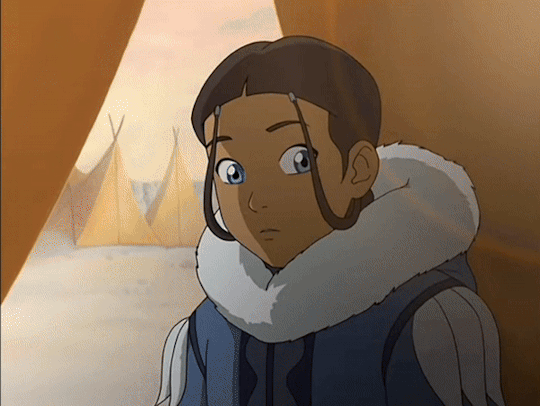
We see that she is intrigued and curious of him, and very excited about his presence. She is endeared and amused by his antics. She is rediscovering her childish side with his help. She is confiding in him about her own trauma surrounding the Fire Nation's genocide of the Southern Waterbenders. She is willing to go against her family and tribe ans leave them behind to go to the Northern Water Tribe with Aang. We also see her determination to save him when he is captured.
As the show moves on and the plot kicks into gear, we do shift more into Aang's perspective. We see his physical attraction to her, and while we don't see Katara's attraction quite as blatantly, there are hints of her interest in his appearance.

This is where we get deeper into the concept of Aang and Katara's mutual interest and attraction for one another. While her perspective is more subtle than most would like, Katara is not purely an object of Aang's desire, no more than he is purely an object of her desire.
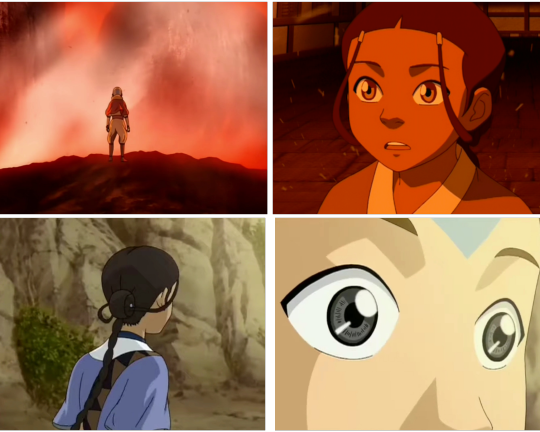
When analysing this aspect of Katara and Aang's relationship, I couldn't help but be reminded of how Célene Sciamma's Portrait of a lady on fire (in my personal opinion, one of the best studies of the female gaze ever created) builds up its romance, and how it places a strong emphasis on the mutuality of the female gaze.
Portrait of a lady on fire's cinematography is very important to the film. We see the world through the perspective of our protagonist, a painter named Marianne. We also see her love interest, Héloïse, the woman whom she is hired to paint a portrait of, through Marianne's lense.
We see Marianne analyse Héloïse's appearance, her beauty. We look purely through Marianne's eyes at Héloïse for a good part of the movie, but then, something unexpected happens. Héloïse looks back. At Marianne, therefore, in some way, also at the audience. While Marianne was studying Héloïse, Héloïse was studying Marianne.
We never shift into Héloïse's perspective, but we see and understand that she is looking back at us. Not only through her words, when she for example comments on Marianne's mannerisms or behaviours, but also hugely through cinematography and acting of the two amazing leads. (Noémie Merlant as Marianne and Adèle Haenel as Héloïse. They truly went above and beyond with their performances.)
This is a huge aspect of the female gaze's implementation in the film. The camera focuses on facial expressions, eyes and body language, seeking to convey the characters' emotions and feelings. There's a focus on intense, longing and reciprocated eye contact (I have dubbed this the Female Gays Gaze.). The characters stand, sit or lay facing each other, and the camera rarely frames one of them as taller than the other, which would cause a sense of power imbalance.
The best way to describe this method of flimaking is wanting the audience to see the characters, rather than to simply look at them. Sciamma wants us to empathise, wants us to feel what they are feeling, rather than view them from a distance. They are to be people, characters, rather than objects.
Avatar, of course, doesn't display the stunning and thoughtful cinematography of Portrait of a Lady on Fire, and Katara and Aang's relationship, while incredibly important, is only a part of the story rather than the focus of it.
However, the 'Kataang moments' we are privy to often follow a similar convention to the ones between Marianne and Héloïse that I mentioned prior.
Theres a lot of shots of Katara and Aang facing each other, close ups on their faces, particularly eyes, as they gaze at one another.
Katara and Aang are often posited as on equal grounds, the camera not framing either of them as much taller and therefore more powerful or important than the other. Aang is actually physically shorter than Katara, which flies in the face in usual conventions of the male fantasy. (I will get to Aang under the male gaze later in this essay)
And even in scenes when Aang is physically shown as above Katara, particularly when he's in the Avatar state, Katara is the one to pull him down, maintaining their relationships as equals.
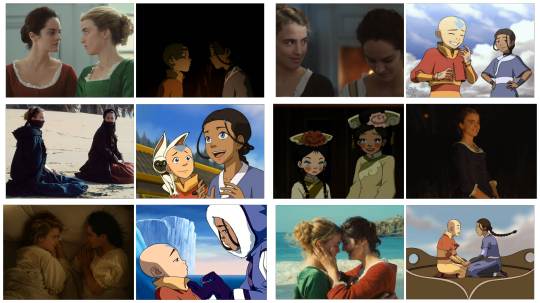
Despite most of the show being portrayed through Aang's eyes, Katara is not a passive object for his gaze, and therefore our gaze, to rest upon. Katara is expressive, and animated. As an audience, we are made aware that Katara has her own perspective. We are invited to take part in it and try to understand it.
Not unlike to Portrait of a Lady on Fire, there is a lot of focus placed on mannerisms and body language, an obvious example being Katara often playing with her hair around Aang, telegraphing a shy or flustered state. We also see her express jealousy over Aang, her face becoming sour, brows furrowed. On one occasion she even blew a raspberry, very clearly showing us, the audience, her displeasure with the idea of Aang getting attention from other girls.
Once again, this proves that Katara is not a passive participant in her own relationship, we are very clealry shown her perspective of Aang. Most of the scenes that hint at her and Aang's focus on their shared emotions, rather than, for example, Katara's beauty.
Even when a scene does highlight her physical appearance, it is not devoid of her own thoughts and emotions. The best example of this being the scene before the party in Ba Sing Se where we see Katara's looking snazzy in her outfit. Aang compliments her and Katara doesn't react passively, we see the unabashed joy light up her face, we can tell what she thinks of Aang's comment.
In fact, the first moment between Katara and Aang sets this tone of mutual gaze almost perfectly. Aang opens his eyes, and looks at Katara. Katara looks back.
There is, once again, huge focus on their eyes in this scene, the movement of Aang's eyelids right before they open draws out attention to that part of his face. When the camera shows us Katara, is zooms in onto her expression as it changes, her blinking also drawing attention to her wide and expressive eyes.

This will not be the first time emphasis is placed on Katara and Aang's mutual gaze during a pivotal moment in the show. Two examples off the top of my head would be the Ends of B2 and B3 respevtively. When Katara brings Aang back to life, paralleling the first time they laid eyes on one another. And at the end of the show, where their gaze has a different meaning behind it.
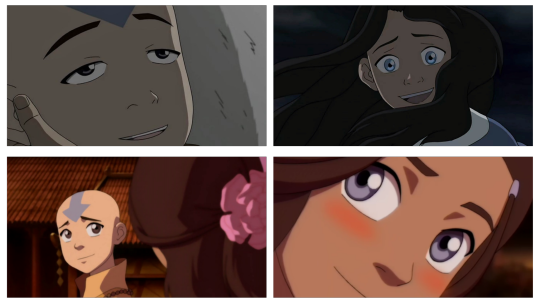
We see Katara's emotions and her intent telegraphed clearly in these instances.
In Book 1, we see her worry for this strange bald boy who fell out of an iceberg, which melts away to relief and a hint of curiosity once she ascertains that he isn't dead.
In B2 we once again see worry, but this time it's more frantic. Her relationship with Aang is much dearer to her heart now, and he is in much worse shape. When we see the relief on her face this time, it manifests in a broad smile, rather than a small grin. We can clearly grasp that her feelings for Aang have evolved.
In B3, we step away from the rule because Aang isn't on the verge of death or unconsciousness for the first time. It is also the first time in a situation like this that Aang isn't seeing Katara from below, but they are on equal footing. I attribute this to symbolising change of pace for their relationship.
The biggest obstacle in the development of Katara and Aang's romance was the war, which endangered both their lives. Due to this, there was a hesitance to start their relationship. In previous scenes that focused this much on Aang and Katara's mutual gaze, Aang was always in a near dead, or at least 'dead adjacent' position. This is is a very harsh reminder that he may very well die in the war, and the reason Katara, who has already endured great loss, is hesitant to allow her love for him to be made... corporeal.
However, now Aang is standing, portraying that the possibily of Katara losing him has been reduced greatly with the coming of peace, the greatest obstacle has been removed, and Katara is the one to initiate this kiss.
Concurrently, Katara's expression here does not portray worry or relief at all, because she has no need to be worried or relieved. No, Katara is blushing, looking directly at Aang with an expression that can be described as a knowing smile. I'd argue that this description is accurate, because Katara knows that she is about to finally kiss the boy she loves.
Ultimately, Katara is the one who initiates the kiss that actually begins her and Aang's romantic relationship.
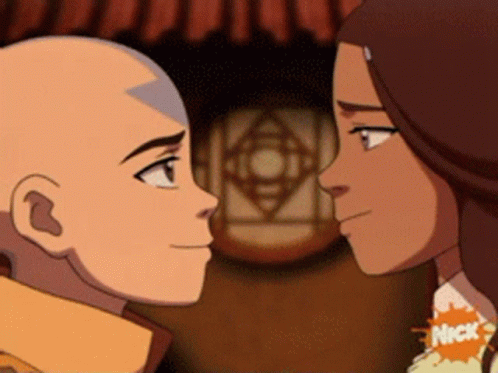
Kataang's appeal to women is reflected in how Katara is almost always the one to initiate physical affection with Aang. With only 3 exceptions, one of which, the Ember Island kiss being immediately shown by the narrative as wrong, and another being a daydream due to Aang's sleep deptivation. The first moment of outwardly romantic affection between Aang and Katara is her kissing his cheek. And their last kiss in the show is also initiated by Katara.
I won't falsely state that Kataang is the perfect representation of the female gaze. Not only because the storyline has its imperfections, as every piece of media has. But also because I simply belive that the concept of the female gaze is too varied and nebulous to be fully expressed. With this essay, I simply wanted to prove that Kataang is most certainly not the embodiment of catering to the male gaze either. In fact it is quite far from that.
The aspects of Kataang that fall more towards embodying the female gaze don't just appeal to women. There's a reason a lot of vocal Kataang shippers you find are queer. The mutual emotional connection between Katara and Aang is something we don't have to identify with, but something we are still able to emphasise with. It's a profound mutual connection that we watch unfold from both perspectives that sort of tracends more physical, gendered aspects of many onscreen romances. You just need to see instead of simply look.
✨️Bonus round✨️
Aang under the gaze
This started off as a simple part of the previous essay, however I decided I wanted to give it it's own focus, due to the whole discourse around Aang being a wish-fullfilling self insert for Bryke or for men in genral. I always found this baffling considering how utterly... unappealing Aang is to the male gaze.
It may surprise some of you that men are also subjected to the male gaze. Now sadly, this has nothing to do with the male gaze of the male gays. No, when male characters, usually the male protagonist, are created to cater to the male gaze, they aren't portrayed as sexually desirable passive objects, but they embody the active/masculine aide of the binary Laura Mulvey spoke of in the quote I shared at the beginning of this essay.
The protagonist under the male gaze is not the object of desire but rather a character men and boys would desire to be.
They're usually the pinnacle of traditional, stereotypical masculinity.
Appearance wise: muscular but too broad, chiseled facial features, smouldering eyes, depending on the genre wearing something classy or some manner of armour.
Personalitywise they may vary from the cool, suave James Bond type, or a more hotblooded forceful "Alpha male" type. However these are minor differences in the grand scheme of things. The basis is that this protagonist embodies some manner of idealised man. He's strong, decisive, domineering, in control, intimidating... you get the gist. Watch nearly any action movie. There's also a strong focus placed on having sway or power over others. Often men for the male gaze are presented as wealthy, having power and status. Studies (that were proved to be flawed in the way the data was gathered, I believe) say that womem value resources in potential male partners, so it's not surprising that the ideal man has something many believe would attract "mates". [Ew I hated saying that].
Alright, now let's see how Aang holds up to these standards.

Well... um...
Aang does have power, he is the Avatar. However, he is often actually ignored, blown off and otherwise dismissed, either due to his age or his personality and ideals being seen as unrealistic and foolish. Additionally, Aang, as a member of a culture lost a century ago, is also often posited as an outsider, singled out as weak, his beliefs touted as the reason his people died out and.
Physically, Aang doesn't look like the male protagonist archetype, either. He isn't your average late teens to brushing up against middle aged. Aang is very much a child and this is reflected in his soft round features, large eyes and short, less built body. This is not a build most men would aspire to. Now, he still has incredible physical prowess, due to his bending. But I'm not sure how many men are desperate to achieve the "pacifist 12 year old" build to attract women.
Hailing from a nation that had quite an egalitarian system, Aang wouldn't have conventional ideas surrounding leadership, even if he does step up into it later. He also has little in the way of possessions, by choice.
As for Aang's personality, well...

I mean I wouldn't exactly call him your average James Bond or superhero. Aang is mainly characterised through his kindness, empathy, cheerful nature and occasional childishness (which slowly is drained as the trauma intesifies. yay.)
Aang is very unwilling to initiate violence, which sets him aside from many other male protagonists of his era, who were champing at the bit to kick some ass. He values nature, art, dance and fun. He's in tune with his emotions. He tries to desecalate situations before he starts a fight.
Some would say many of Aang's qualities could be classified as feminine. While the other main male characters, Zuko and Sokka try to embody their respective concepts of the ideal man (tied to their fathers), Aang seems content with how he presents and acts. He feels no need to perform masculinity as many men do, choosing to be true to his emotions and feelings.
These "feminine" qualities often attract ridicule from other within the show. He is emasculated or infantiliased as a form of mockery multiple times, the most notable examples being the Ember Island play and Ozai tauntingly referring to him as a "little boy". Hell, even certain Aang haters have participated in this, for example saying that he looks like a bald lesbian.
I'd even argue that, in his relationships with other characters, Aang often represents the passive/feminine. Especially towards Zuko, Aang takes on an almost objectified role of a trophy that can be used to purchase Ozai's love. [Zuko's dehumanisation of others needs to be discussed later, but it isn't surprising with how he was raised and a huge part of his arc is steerring away from that way of thinking.]
Aang and Zuko almost embody certain streotypes about relationships, the forceful, more masculine being a literal pursuer, and the gentler, more feminine being pusued.
We often see Aang framed from Zuko's perspective, creating something akin to the mutual gaze of Katara and Aang, hinting at the potential of Zuko and Aang becoming friends, a concept that is then voiced explicitly in The Blue Spirit.
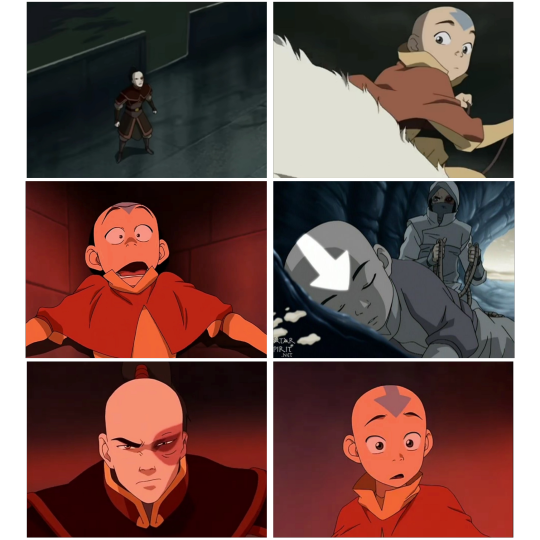
However, unlike Katara, Zuko is unable to empathise with Aang at first, still seeing Aang as more of an object than a person. We have here an interesting imbalance of Aang seeing Zuko but Zuko meerly looking at Aang.
There is a certain aspect of queer metaphor to Zuko's pursuit of Aang, but I fear I've gotten off topic.
Wrapping this long essay up, I want to reiterate that I'm not saying that Zutara isn't popular with women. Most Zutara shippers I've encountered are women. And most Kataang shippers I've encountered are... also women. Because fandom spaces are occupied predominantly by women.
I'm not exactly making a moral judgement on any shippers either, or to point at Kataang and go: "oh, look girls can like this too. Stop shipping Zutara and come ship this instead."
I want to point out that the juxtaposition of Zutara and Kataang as respectively appealing to the feminine and masculine, is a flawed endeavour because neither ship does this fully.
The concept of Kataang being a purely male fantasy is also flawed due to the points I've outlied in this post.
Are there going to be male Kataang shippers who self insert onto Aang and use it for wish fulfilment? Probably. Are there going to be male Zutara shippers who do the same? Also probably.
In the end, our interpretation of media, particularly visual mediums like film are heavily influenced by our own biases, interests, beliefs andmost importantly our... well, our gaze. The creators can try to steer us with meaningful shots and voiced thought, directing actors or animating a scene to be a certain way, but ultimately we all inevitably draw our own conclusions.
A fan of Zutara can argue that Kataang is the epitome of catering to the male gaze, while Zutara is the answer to women everywhere's wishes.
While I can just as easily argue the exact opposite.
It really is just a matter of interpretation. What is really interesting, is what our gaze says about us. What we can see of ourselves when the subject gazes back at us.
I may want to analyse how Zutara caters to the male gaze in some instances, if those of you who manage to slog through this essay enjoy the subject matter.
#ok getting off my soapbox#i forgot how much i love to write these long sprawling essays...#kataang#pro kataang#aang#pro aang#aanglove#aang defense squad#pro katara#katara defense squad#kataang love#zuko#avatar#atla#avatar: the last airbender#the last airbender#avatar the last airbender#aang the last airbender#anti zutara
422 notes
·
View notes